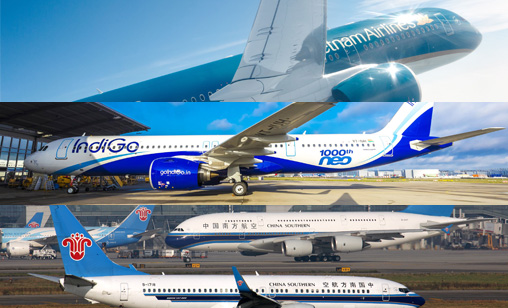Main Story
Big jets out smaller jets in
Asia-Pacific airline operating fleets are a shadow of pre-pandemic numbers. When they will return to pre-COVID levels, if they ever do, is anyone’s guess. Already some familiar commercial jet types are disappearing at airlines as carriers reshape their networks for a post-pandemic world. Associate editor and chief correspondent, Tom Ballantyne, reports.
February 1st 2022
Across the region, airline capacity recovery lags behind the rest of the world, held back by the reluctance of several Asia-Pacific governments to reopen their borders to international travellers until zero-COVID status is achieved. Read More »
In 2022, Asia-Pacific carriers are scheduled to take delivery of 500 aircraft, but that is only half the story. Scores of older jets, grounded in the pandemic, will never return to Asia-Pacific skies. Elsewhere, airlines region-wide have had to cancel orders for aircraft or defer deliveries of new airplanes to preserve cash. All parties involved have lost millions.
 |
Being left with no option but to downsize their fleets when passengers evaporated overnight, Asia-Pacific carriers have brought forward retirement of their less fuel efficient planes and focused on rebuilding networks with new jets that offer better operating and emissions efficiency.
A recent report by consultancy CAPA outlined the decimation – and the inevitable restructuring of the global airline fleet - including its forecast of the shape of capacity recovery at Asia-Pacific airlines.
“Many airlines will look significantly different. The pandemic has transformed operating fleets and longer term fleet strategies. The region’s airlines have accelerated the retirement of older types due to the pandemic, catalysing the shift to newer, more efficient aircraft. Order books have been shaken up as airlines adjust to changed market expectations. New orders are starting to emerge with airlines looking to the next phase of their development,” CAPA said.
The good news is the Asia-Pacific has generally avoided airline failures. Aviation data, intelligence and advisory company, IBA, identified 63 airline failures and restructurings worldwide in 2020 and 2021. They are a mix of domestic, low-cost and legacy carriers that have resulted in the temporary or permanent grounding of 1,924 aircraft. IBA anticipates 20 more airlines, covering 200 aircraft, will fail in 2022, bringing the three-year total to 83 carriers and 2,124 affected aircraft. SilkAir has been absorbed into Singapore Airlines while other carriers in the region that have entered administration, notably Philippine Airlines, Garuda Indonesia and Virgin Australia, have survived.
But IBA’s intelligence cautions higher costs could lead to a higher rate of airline failures. “Airlines have taken on significant debt to survive the pandemic with stretched balance sheets bringing them under additional pressure to return to profitability,” it wrote.
In the Asia-Pacific, some aircraft types have been particularly affected by the COVID-19 crisis, CAPA said. Best examples are the largest passenger aircraft – A380s and 747s. Indeed, the report pointed to the extinction of Boeing’s legendary “Queen of the Skies”. There were 41 passenger 747s active in the Asia-Pacific in January 2019. Two years later, there are 10 of the type in service. Korean Air operates three, of which all are the relatively new 747-8 variant. Air China accounts for the remaining seven.
 |
| “The [current] situation demonstrates the resilience of the industry. “They [airlines] have had a lot of support from their shareholders, including governments, but the airline industry has been working together, not only the airlines but the lessors and the manufacturers to organize their operations and stay afloat until the recovery takes root. It would not have been possible without the collaboration of everyone in the industry” |
| Subhas Menon Association of Asia-Pacific Airlines director general |
At January 31, 2020, 65 A380s were flying in the region versus one inactive of the aircraft type, records the CAPA fleet database. The active number fell to five by April 2020 and did not increase appreciably until October 2021. As of January 24 this year, the active number of A380s increased to 12 with 53 inactive. Of the 12 active in the region, Singapore Airlines accounts for seven, China Southern Airlines for three and Qantas and Korean Air one each.
Also on the track to long-term storage is the B777-200. There were 114 in service in the Asia-Pacific pre-pandemic, including -200ERs and -200LRs. At press time, there were 19 of the passenger version active in the region.
The numbers are considerably better when all B777 variants are included. For the broader B777 family, 265 of the passenger version in the region – or 69.7% – are active with 115 inactive. The situation is broadly similar for A330s, with 73.1% of the 554 aircraft operating in the region in service.
It is a completely different story for newer aircraft such as the A350 and the 787. “Airlines are more inclined to use their newer and more efficient aircraft before bringing older types out of storage,” CAPA wrote. “There are 372 787s in service in the Asia-Pacific and 28 inactive. New deliveries mean there are actually slightly more 787s in service than before the pandemic began. The trend is similar for A350s. There are 216 in service and 16 inactive,” the consultancy has calculated.
Nevertheless, major Asia-Pacific carriers are reducing and adjusting their fleets. As has been well reported, Malaysia Airlines is trying to sell all six of its A380s. Qantas, Singapore Airlines and Thai Airways International also intend to trim their A380 fleets. Air New Zealand announced last year that its stored B777-200s will not return to service.
“Several Asia-Pacific airlines opted to accelerate retirement plans for older wide-bodies as a result of the pandemic. Japan’s major airlines have done this, phasing out many 777s earlier than planned. All Nippon Airways retired 22 of its 777s in the fiscal year ending last March 31,” CAPA reports.
“Japan Airlines (JAL) has ceased operations of all 13 of its 777-200s and -300s used on domestic routes before the pandemic and retired six of its 11 777-200ERs. The carrier will continue to operate 13 777-300ERs on international routes, but eventually they will be superseded by the A350-1000s the airline has ordered.”
| “India is different. After four weeks of consistent capacity cuts India continues to see significant available seat kilometres reduced week-on-week with another 356,000 fewer seats on sale this week [late January] and all major airlines in India cutting capacity in some way or other. But as we have seen in the past, the Indian market recovers very quickly. By the end of February it could be at more than 3.5 million seats. It is a fast-changing market. Another market that moves quickly is Vietnam. Its airline capacity continues to grow back with a 17% increase on the previous week [mid-January] allowing the country to move three places higher in the list, overtaking the UAE, Saudi Arabia and Canada” |
| John Grant OAG chief analyst |
The COVID-19 crisis has affected the region’s airline fleet in multiple ways. “On the one hand, the early retirement of older types will help reduce the average age of the fleets of various airlines. Conversely, many airlines have deferred or even cut back aircraft orders, delaying fleet refresh plans. Overall, the competing trends should have the effect of accelerating the move to a younger fleet when the dust settles,” CAPA said.
“This will have obvious benefits for efficiency and for reducing emissions. Narrow-bodies have returned to service more quickly than wide-bodies, which is to be expected given domestic services have been less affected by border closures. The ratio in service has varied widely among Asia-Pacific sub-regions, with China and Southeast Asia at opposite ends of the spectrum. However, it appears there has been a general sustained increase in the region’s active fleet in recent months.”
One of the most intriguing questions for Asia-Pacific aviation in the post-pandemic world will be the scale of the advantage LCCs will have over their full service brethren. It has become widely accepted LCCs will recover faster from the COVID-19 crisis. But why is that, and where does that leave the Full Service Carriers (FSC)?
In many of the region’s markets, FSCs were under severe pressure from LCCs before the coronavirus pandemic. Legacy airlines likely will find it even tougher in the next few years. Any post-COVID advantage could further entrench the LCCs in certain countries where they were already dominant, analysts believe.
To date, there have been no major narrow-body order cancellations or airline collapses among LCCs holding the largest order books. Some have signaled they remain committed to their narrow-body orders, but most of the LCC sector has had to negotiate delivery slowdowns.
In the meantime, the Omicron variant of COVID has jammed on the brakes of industry recovery. Last month, OAG chief analyst, John Grant, said the digital flight information, intelligence and analytics provider believed airlines were spooked by Omicron. Once again they are cutting capacity with another 18 million seats forecast to be removed from sale to March 31. The result is more than 51 million seats being “lost” from the first quarter of this year.
“We remain at airline capacity levels 30% below the same week in 2020. At a regional level, performances are mixed. In Central America and West Africa capacity is within 10% of 2020 levels. In the Southwest Pacific, North Africa and Western Europe available capacity remains more than 40%. Southeast Asia continues to struggle to break the 50% point of recovery,” Grant wrote.
“As we have said so many times, each market is having its own COVID event and recovering, or not, at different paces. New Zealand has announced easing of border restrictions but Japan has faced more outbreaks and tighter restrictions have been imposed in Hong Kong,” Grant said.
Australia is another market where more capacity cuts have been made week-on-week. Its [recent] near 12% reduction in offered seats is based around domestic airline capacity forecasts. Jetstar has cut capacity by 17%, Qantas by 16% and Virgin Australia by 9%.
“Taking a criterion of at least half a million scheduled seats per week two years ago, we have tracked the 20 markets struggling to recover. The six slowest recoveries are in Southeast Asia, with Hong Kong at 17% of its 2020 capacity levels. Singapore and Chinese Taipei are at less than 30% of normal production levels. These three countries are all dependent on international capacity, specifically to China, Australia and New Zealand, which makes any noticeable improvement very unlikely in the first half of this year given the situation now,” Grant said.
While the pandemic has forced far-reaching changes at airlines, a forecast that is never challenged is that global aviation growth increasingly will be driven by Asia-Pacific carriers.
“So the immediate priority for airlines is to optimize fleet composition to cater to ascending demand. Strong cargo demand has seen some airlines convert passenger aircraft to freighters to meet the supply chain market for medical supplies and vaccines around the world. “Longer term, the region’s airlines recognize the recovery from COVID-19 presents opportunities to improve their environment sustainability credibility. The grounding of the aircraft fleet provided opportunity for return to service of more fuel efficient aircraft and the retirement of older fleet types. If the boom years had not been interrupted, it is hard to imagine airlines taking needed capacity out of service at the expense of revenue opportunities.” |
Bills Sarah says:
November 21st 2023 11:55am